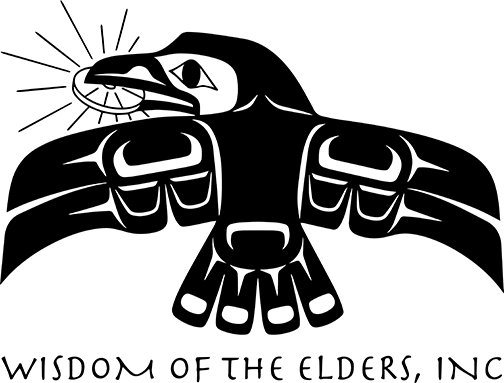The Assiniboine and the Gros Ventre
with Arlie Neskahi
From the journal of William Clark::
Meriwether Lewis, April 25 th. The whole face of the country was covered with herds of buffalo, elk, and antelopes. They are so gentle that we pass near them while feeding, without appearing to excite any alarm among them. They frequently approach us more nearly to discover what we are.
Neskahi:
Welcome to Wisdom of the Elders. I’m Arlie Neskahi. On April 14th, 1805, the expedition passed a small creek. The creek already had a name, but Lewis and Clark gave it a new one. They named it after their interpreter, Touissaint Charbonneau, the French adventurer who had previously camped there. Lewis believed it to be the farthest any white man had ventured up the Missouri. Perhaps this was a momentous occasion for the explorers, but in the vast Northern Plains, crossed for thousands of years by the original tribes, the achievement loses some of its significance.
Images below are from the National Gallery of Art: www.nga.gov

George Catlin American, 1796 - 1872 A Buffalo Wallow, 1861/1869 oil on card mounted on paperboard, 46.7 x 62.5 cm (20 x 26 1/4 in.) Paul Mellon Collection 1965.16.178
What is striking about the Corps’ journey from the Mandan villages to the headwaters of the Missouri is the abundance of life they encountered. Not one Indian was sighted during the entire journey, but sightings of wildlife abound. Lewis and Clark’s journals are teeming with mosquitoes, elk, deer, buffalo, prairie dogs, hornets, magpies, wolves, bald eagles, bighorn sheep, and standing above them all, the lord of the plains, the ferocious grizzly bear.
Although no Indians were sighted by the Corps, there were many signs of Native occupancy: abandoned camps, war lodges, an antelope trap, and a lone Assiniboine dog. One man found a scarlet cloth several meters long placed in a tree as an offering. A lodge-pole washed onto a beach, a rawhide football, an empty camp, and a pair of moccasins, indicate the haunting presence of the multitude of Native people they had expected to find on the Plains.
Robert Four Star:
There’s an ancient story here of our people that they seen these people coming up the river. They was a little excited. They came back to the camp and they told a story that these people are coming here now. After they had a council, they just said, “Just trail them, don’t bother them unless of course they threaten you, then you can do what you have to, but we’re not here to harm anybody, these white people that are coming. And so trail them to the Musselshell,” which spills into the Missouri River from the south close to Fort Belknap somewhere.

George Catlin American, 1796 - 1872 Mired Buffalo and Wolves, 1861/1869 oil on card mounted on paperboard, 46.2 x 62.9 cm (18 1/2 x 24 3/4 in.) Paul Mellon Collection 1965.16.213While most Indians were elsewhere hunting buffalo, some tribal traditions suggest that Lewis and Clark were not missed by the Indians. In fact, they were being watched. Assiniboine historian, Robert Four Star.
Neskahi:
In today’s program we will feature the Assinboine and the Gros Ventre. In the early 1900’s, these tribes followed the buffalo across the northern regions of Montana and North Dakota and far into Canada. The Assiniboine, speaking a language related to Sioux, originally migrated from the Great Lakes region. The word Assinboine is from the Cree, meaning “cooks with heated stones,” after their method of making soup. They call themselves Nakona, or Nakonabi,meaning “the friendly people.” The Assiniboine acted as middle men in the trade from the Hudson’s Bay Company to the Mandan villages, exchanging guns and metal goods for horses and robes. Their position gave them great influence in the fur trade well into the nineteenth century. Today, they live on the Fort Peck and Fort Belknap Reservations in north central Montana.
Assiniboine educator, Joe McGeshick was born and raised at Fort Peck.
Joe McGeshick:
The Assiniboin had been in contact with whites for fifty years before Lewis and Clark, were trapping and trading with Frenchmen who had stayed on after the French and Indian War in 1763 when Britain comes to dominate the western half of the continent in what we know as Canada today through the Hudson’s Bay Company.
Music:
With Faces Joyous and Beaming with Light
Ben Koen
Songs from Green Mountain
The Gros Ventre were at first closely associated with the Algonquin-speaking Arapaho. Gros Ventre and Arapaho oral traditions record that they split up near the Red River in Canada sometime in the early 1600’s. Pushed west by smallpox and warfare, the Gros Ventre were among the last of the tribes to move onto the Northern Plains.
This is Gros Ventre elder, Elmer Main:
Elmer Main:
The Gros Ventres were first found with the Algonquins in Pennsylvania. The colonies started rolling in and taking over their land. The Upper Quarter Clan wound up down the Missouri River. A lot of people had ships sailing the Missouri up to Fort Benton, and so the Gros Ventre, they were starving, and so the French fed them, and their bellies swelled up. So the French said “Gros Ventre.” That means “big belly” but that wasn’t their real name.
They call themselves the A’ani’ meaning “White Clay People.” They now live on the Fort Belknap Indian Reservation in north central Montana.
Music:
With Faces Joyous and Beaming With Light
Ben Koen
Songs from Green Mountain
Neskahi:
I’m Arlie Nesakhi, and this is Wisdom of the Elders.


